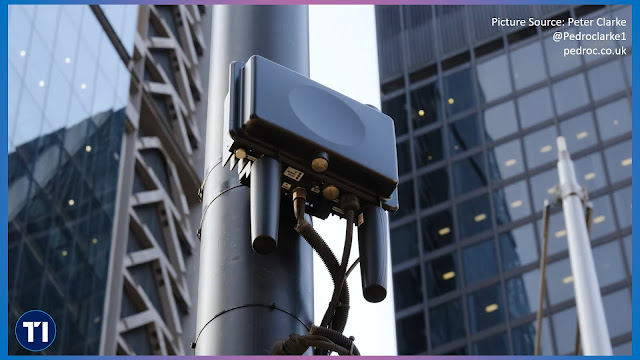It's been a while since I posted some small cell pictures from the USA. It's always nice of people to share their pics on Twitter and here are some of them I found interesting.
New AT&T small cell installed within the last week or so. They have a dense small cell grid in my area. Don’t have an AT&T line to test unfortunately. @Techlife32 @Terrell352 @SneedTech @carlostech702 pic.twitter.com/p5pU4Ex4x4
— Joe (@mobowhunting96) June 20, 2021
See the AT&T small cell in front of the VZ Flag-cell?
— Steve-O Pure-Blood 🚫 💉 (@SteveOStereo) June 14, 2021
AT&T is planting them like WEEDS in the Northern Broward , Southern Palm Beach County , Florida area! And AT&T is putting them in KEY areas... In front of Fire Stations, Schools, Apartment Buildings, and filling in! pic.twitter.com/lx3xlUoXq7
AT&T Small Cell in Lauderhill, FL. Amazing performance! pic.twitter.com/DdfjSXZsgn
— Da 954 (@CellTowers954) March 7, 2021
Omni pole-topper by AT&T. One sector strand mount by T-mobile. Pico Blvd in Santa Monica, CA. pic.twitter.com/vE6CTeitBd
— Dr Jonathan L Kramer (@DrJLKramer) February 1, 2021
Another sector of the AT&T rooftop site in West Los Angeles. Note the 'effective' of use of yet another traffic bollard as a RF warning device. pic.twitter.com/qBc4DdZo1i
— Dr Jonathan L Kramer (@DrJLKramer) August 19, 2020
Here's a completely accessible AT&T macrocell site in West Los Angeles. The left cantenna isn't connected. The right cantenna seems to be cabled for only two sectors. I always love seeing plastic traffic bollards 'protecting' the public from RF. At least these are still standing. pic.twitter.com/2z6u1ioVDF
— Dr Jonathan L Kramer (@DrJLKramer) August 19, 2020
Color coordinated cell site. pic.twitter.com/jNUuimhbXJ
— Dr Jonathan L Kramer (@DrJLKramer) June 27, 2020
"You want some G's with that burger?" AT&T flagpoles at Mickey-D's. pic.twitter.com/EUAOLItTH5
— Dr Jonathan L Kramer (@DrJLKramer) February 28, 2020
AT&T in Santa Monica. pic.twitter.com/ED3WI74Pws
— Dr Jonathan L Kramer (@DrJLKramer) July 27, 2019
On it's website, Raycap has a case study with AT&T:
To see a range of solutions for concealing small cell wireless sites, look no farther than Dallas, Texas, home to AT&T corporate headquarters. Raycap worked with the carrier to complete two very different concealment projects.
- Six custom-designed wall-mounted enclosures, designed, manufactured and painted to match the granite walls of AT&T’s buildings and provide 5G mmWave coverage around the AT&T Discovery District
- Nearby, highly customized small cell poles were engineered to meet the carrier’s needs, the utility’s access requirements, and the city’s aesthetic guidelines—including an integrated image of the iconic Pegasus logo.
These two projects show how Raycap-led collaboration among all stakeholders can solve challenging wireless deployments: wall mounted, rooftop mounted, integrated in poles, and others.
You can download the PDF here.
Related Posts:
- The 3G4G Blog - AT&T Blog: "Providing Connectivity from Inside a Cactus"
- The 3G4G Blog: Inside AT&T Towers
- Telecoms Infrastructure Blog: MatSing's High-Capacity RF Lens Antennas
- Telecoms Infrastructure Blog: AT&T's Small Base Stations on Wooden Poles
- Telecoms Infrastructure Blog - AT&T: Small Cells advertisement and Cell On Wheels (COW)
- Telecoms Infrastructure Blog: Small Cells to improve service in Disney parks
- The 3G4G Blog: Macrocells, Small Cells & Hetnets Tutorial
- Connectivity Technology Blog: AT&T Celebrates 1 million FirstNet Connections with FirstNet One, a 55-foot Aerostat
- Operator Watch Blog - AT&T: Winning the Connected Car market in the USA
- The 3G4G Blog: AT&T Cybersecurity Experts Provide 5G Security Overview


